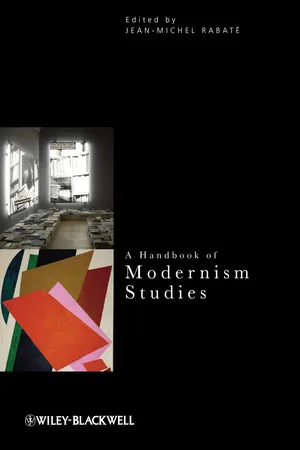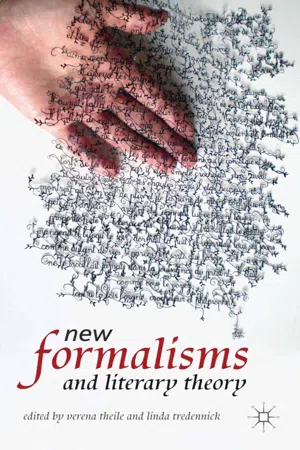Formalism Literary Theory
Formalism literary theory emphasizes the intrinsic structure and form of a literary work, focusing on elements such as language, style, and literary devices rather than external factors like historical or biographical context. It seeks to analyze the text as a self-contained entity, highlighting the significance of form in conveying meaning and aesthetic value.
6 Key excerpts on "Formalism Literary Theory"
- eBook - ePub
- Jean-Michel Rabaté(Author)
- 2013(Publication Date)
- Wiley-Blackwell(Publisher)
...Chapter 24 Aesthetic Formalism, the Form of Artworks, and Formalist Criticism Jonathan Loesberg As my title indicates, the words “form” and “formalism,” even when limited to the contexts of aesthetic and literary theory, can have different meanings and refer to ostensibly very different formal objects. Specifically, “formalism” can refer to an aesthetic theory about either what artworks do or what they ought to do: they are autonomous and either do as a matter of definition or ought to, as a matter of evaluation, attend to their autonomous aesthetic form. But, of course, formalism can also refer to a school of art criticism, opposed to various other schools, claiming that art criticism, at least if it wishes to focus on the specifically artistic qualities of artworks, ought to attend to the features of form that makess the object of its attention an artwork and not something else. The Oxford English Dictionary, it should be noted, dates the first use of the word “formalism” in an aesthetic sense to the Russian Formalists and, without offering a separate definition of the second use, under “formalist,” offers the first citation that describes a type of criticism as occurring in 1967. Given the work, not only of the Russian Formalists, but of Adorno, Greenberg, and the New Critics, one can doubt that that is the earliest such usage, but one cannot doubt that the concept dates, as does the first usage, to the rise of modernism in the early twentieth century. From this coincidence of occurrence that we will see will emerge as causal, I will make three related claims: First, since modernism took itself to be an aesthetic built on the classic Aesthetic arguments of the prior one hundred and fifty years, the original definitions of those theories, as exemplified by Kant and Hegel, will lead to necessary, though productive contradictions in modernism's self-definitions...
- eBook - ePub
- V. Theile, L. Tredennick, V. Theile, L. Tredennick(Authors)
- 2013(Publication Date)
- Palgrave Macmillan(Publisher)
...As David Lodge puts it in discussing elements of fictional narrative: All good criticism is … necessarily a response to the creative use of language, whether it is talking explicitly of ‘plot’ or ‘character’ or any other of the categories of narrative literature. These terms are useful – indeed essential – but the closer we get to defining the unique identity and interest of this plot, of that character, the closer we are brought to a consideration of the language in which we encounter these things. 8 The early formalism of the New Criticism, in the 1930s and 1940s, assumed that the aspects of a text emphasized by New Critical techniques – paradox, irony, a unity composed of ‘resolved stresses,’ to name only a prominent few – were, by and large, peculiar to literary texts, and intrinsic to them. My representation of New Formalist criticism assumes neither the distinctiveness of literary language nor the intrinsic character of the textual features disclosed by formalist analysis. 9 Instead, my advocacy of formalism and close reading is tied to a particular idea of the meaning, significance, aims, and purposes of literary criticism. Nor am I advocating formalist criticism exclusively. What I am contending is, first, that formalist analysis should be a vital part of any interpretive method that cares to be called ‘literary critical,’ and, second, that it produces or discloses dimensions of textual meaning and textual performance that are of the greatest readerly, cultural, and social significance. This formalist commitment is in part an attempt to recover the specificity of the literary obscured by a number of contemporary modes of reading and interpretation...
- eBook - ePub
- Sara Upstone(Author)
- 2017(Publication Date)
- Teach Yourself(Publisher)
...2 Formalism and new criticism Literary criticism is a matter of not only when but where. The multitude of perspectives now available in the study of literature is testament to a contemporary global culture that has, over time, drawn its influences from across the world. In the early twentieth century, everyone, it seemed, was reading poetry: decadent, aesthetic poetry and modernist poetry. And the reading of this poetry changed the face of literary studies. In continental Europe, these readers would come to develop a literary method known as formalism. In Britain and the United States, developments in reading practice would be called practical criticism and – later – new criticism. Both schools of thought would go on to have profound influence on how we read literary texts. Both new critics and formalists are interested in what is on the page. They argue that it is only textual detail that should be of interest. The Anglo-American poet T. S. Eliot, writing in his essay ‘Tradition and the Individual Talent’ (1919), argues that good poetry relegates the personality of the poet and his emotions in favour of artistry that keeps the reader’s attention on the text. At the centre of this are two facets central to early twentieth-century criticism: firstly, an intense focus on the text and, secondly, a preoccupation with quality that would evolve into the contemporary idea of the literary canon. ‘Poetry is not a turning loose of emotion, but an escape from emotion; it is not the expression of personality, but an escape from personality.’ T. S. Eliot, ‘Tradition and the Individual Talent’ (1919) Spotlight T. S. Eliot is famous for his ‘difficult’ modernist poetry. He is famously quoted as having declared, ‘A play should give you something to think about. When I see a play and understand it the first time, then I know it can't be much good.’ Practical criticism When the academic I. A...
- eBook - ePub
- Andrew Bennett(Author)
- 2004(Publication Date)
- Routledge(Publisher)
...4 FORMALISM, FEMINISM, HISTORICISM Since its inception in the nineteenth century, literary studies in its professional or academic mode and as it is taught at universities in Europe and North America has been dominated by debates over the nature and the status of the author and indeed over the legitimacy of addressing issues of authorship at all. The question of the author may even be conceived, as it is by Seán Burke, in terms not only of a question in literary theory but as ‘ the question of theory’ (Burke 1998: 191, italics added). In other words, the way that authorship is understood may be said to define literary theory, and therefore to determine the way that literature and reading itself are conceived. In this chapter, I will briefly survey three major strands in twentieth-century literary criticism and theory – formalism, feminism, and new historicism – in order to indicate ways in which the question of the author is fundamental to such thinking about literature, literary criticism and literary theory, even when it seems not to be. The author, we might say, is an inescapable factor in criticism and theory, not least when she is most firmly being pronounced dead. FORMALISM Professional academic criticism emerged in the late nineteenth and twentieth centuries out of the disciplines of rhetoric, philology, literary history, and literary editing, all of which have their own distinctive relationships with the question of the author. Academic criticism as such may be said to have been born out of a reaction against the idea that the author stands at the centre of the work of literary interpretation...
- eBook - ePub
Key Concepts
A Guide to Aesthetics, Criticism and the Arts in Education
- Trevor Pateman(Author)
- 2016(Publication Date)
- Routledge(Publisher)
...Form, Formalism DOI: 10.4324/9781315625621-21 Formalism, simply as a preoccupation with the form of a work of art, exists in three domains. Artists can be preoccupied with form; aesthetic experience can be located in relation to the experience of form; and critics and theorists can concern themselves with the form of works. First, it is hard to imagine an artist not preoccupied with form, though Oscar Wilde in ‘The Decay of Lying’ (1891) complains that neglect of form is all too common. There are poets and novelists so urgently oppressed by the need to express themselves or transmit a message that they quite neglect to consider how best to express or transmit what they have to say. Such artists will, of course, generally experience form in its coercive aspects, as when they are told by a potential publisher or producer that their novel simply has too many characters or that their play is too long (and boring). For artists not negligent of form, content and form may be experienced as antagonistic: the content refuses to fit the form, the form alters the (meaning of the) content...
- eBook - ePub
The Languages of Literature
Some Linguistic Contributions to Criticism
- Roger Fowler(Author)
- 2016(Publication Date)
- Routledge(Publisher)
...Eight Criticism and the language of literature: some traditions and trends in Great Britain Ignoring the traps of ontological speculation, we can nevertheless assert that a work of literature is usefully considered as a verbal structure, whatever else it may be. This verbal structure may be described. But we assume that description and criticism pursue different goals, since they do not imply one another reciprocally: description, as an activity, is most efficient without critical direction; yet criticism, according to most theoretical and practical efforts in this century, entails the activity of description. ‘Efficiency’ is no doubt an impertinent ideal for criticism, although ‘objectivity’ is probably a desirable attribute—hence the willingness of the twentieth century to accept the label ‘descriptive criticism’ as a shorthand indication of what it is doing. Most of this survey will be devoted to the growth, the rationale, and the techniques of descriptive criticism in England. This emphasis is not intended to imply dismissal of non-critical descriptive studies such as stylistics, metrics, and formal classification of genres. We reject only undirected description of a kind which might result from the logical extension of the New Critical belief that a poem is an autonomous verbal object all of whose characteristics can be discovered by a structural analysis which excludes appeal to externals. This pseudo-procedure would run counter to the most obvious facts about the way we read and come to understand pieces of literature. We start off a reading with information and hypotheses, and the growing perception of literary form depends on progressive accretions and rejections of facts, hunches, and working metaphors. And as we begin a reading active and informed in this way, we begin also with a purpose, a tentative direction. There can be no unmotivated literary study...





